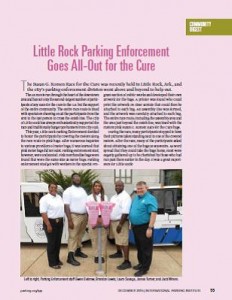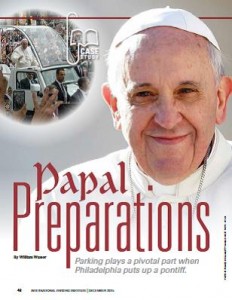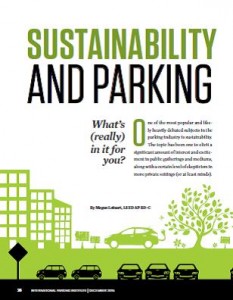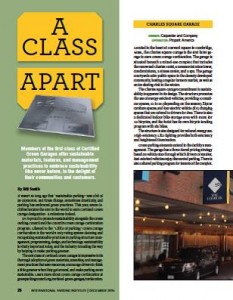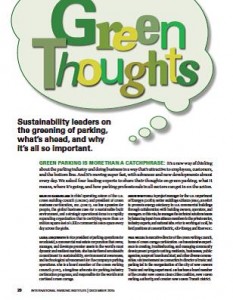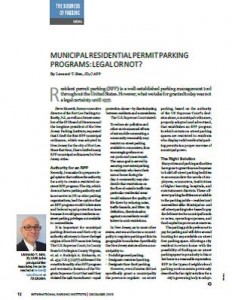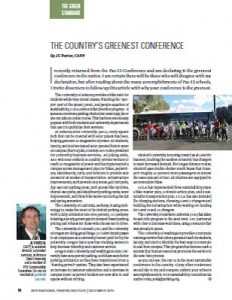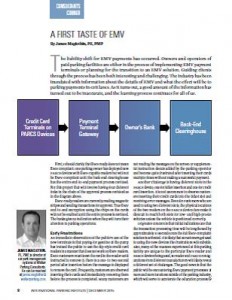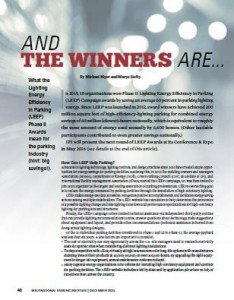 By Michael Myer and Marye Hefty
By Michael Myer and Marye Hefty
In 2015, 18 organizations won Phase II Lighting Energy Efficiency in Parking (LEEP) Campaign awards by saving an average 60 percent in parking lighting energy. Since LEEP was launched in 2012, award winners have achieved 200 million square feet of high-efficiency-lighting parking for combined energy savings of 69 million kilowatt-hours nationally, which is equivalent to roughly the same amount of energy used annually by 6,400 homes. (Other laudable participants contributed to even greater savings nationally.)
IPI will present the next round of LEEP Awards at its Conference & Expo in May 2016 (see details at the end of this article).
How Can LEEP Help Parking?
Advances in lighting technology, lighting controls, and design practices since 2010 have created ample opportunities for energy savings for parking facilities. Realizing this, in 2012 the Building Owners and Managers Association (BOMA), Department of Energy (DOE), Green Parking Council (GPC, an affiliate of IPI), and International Facility Management Association (IFMA) started the LEEP Campaign; IPI was then invited to join as an organizer as the largest and leading association of parking professionals. LEEP’s overarching goal is to reduce the energy consumed by parking facilities through the installation of high-efficiency lighting.
LEEP makes energy-use data accessible, recognizes positive accomplishments, and facilitates energy-saving actions among multiple stakeholders. The LEEP website has calculators to help determine the economics of a possible lighting change and lists lighting incentives and performance specifications for high-efficiency lighting for parking lots and structures.
Finally, the LEEP Campaign offers limited technical assistance via independent third-party entities that can provide lighting recommendations to sites, answer questions about technology, make suggestions about equipment and layout, and provide other recommendations (technical assistance is barred from doing actual lighting designs).
Of the 21 individual parking facilities considered in Phase I and 23 in Phase II, the average payback was less than six years. A few factors are important to consider:
The cost of electricity can vary significantly across the U.S. Site managers need to research electricity costs for specific sites when considering different lighting installations.
To stay competitive with LEDs, virtually all light sources now offer long-life options with manufacturers claiming lives of their products at 40,000; 60,000; or even 100,000 hours. By upgrading the light equipment to longer-life equipment, annual maintenance costs are reduced.
Many regional energy organizations offer rebates for installing high-efficiency equipment and controls for parking facilities. The LEEP website includes a list by state and by application (structure vs. lot) of incentives from across the country.
Airports
Detroit Airport McNamera Terminal Parking and Blue Deck
The Detroit Airport saved nearly 6 million kWh annually in energy by upgrading the lighting at the McNarama parking terminal, a 4.6 million-square-foot parking structure, resulting in a LEEP award for a single parking structure within the airport industry and the LEEP award for annual absolute energy for upgrading the lighting at two parking structures for 7.5 million kWh a year in savings.
Award(s):
- Highest Absolute Annual Savings in a Retrofit at a Single Parking Structure.
- Largest Portfolio-wide Annual Absolute Energy Savings.
Technology: 60-W LED light fixtures and lighting controls
(replaced 175-W metal halide light fixtures).
Parking Specs: two parking structures; 6 million square feet; 18,000 parking spaces.
Savings Summary: 7.5 million kWh saved; 68 percent compared to original design and $770,000 annually.
Denver International Airport East and West Parking Garages
Travelers appreciate the cleaner and brighter light in this retrofit. LEEP recognizes that the lighting power density for this retrofit is 0.05 W/ square feet, which is significantly lower than most current energy codes (0.19 W/square feet) for parking structures. By right-sizing the lighting equipment and lighting choices and by not over-lighting and using the better distribution of new technologies, Denver International Airport maximized energy savings.
Award(s): Exemplary Airport Parking Facility.
Technology: 27-W, 50-W, and 70-W LED light fixtures (replaced 100-W and 150-W metal halide light fixtures with 250-W high-pressure sodium light fixtures, respectively).
Parking Specs: one parking structure; 5 million square feet; 15,000 parking spaces.
Savings Summary: 4 million kWh saved, a 53 percent savings compared to the original design for an annual savings of $400,000 in electricity savings.
Military Facilities
The Department of Defense (DoD) consumes 1 percent of all the energy (including fuel for transportation) used in the United States.
A vast majority of this is in fuel for vehicles, but building installation energy use (including parking facilities) is still significant.
The Army Reserve 63rd Regional Support Command
The Army achieved energy savings of 85 percent at the Military Equipment Parking facility by replacing multiple medium-wattage HID fixtures with lower-wattage and fewer LED fixtures.
Award(s): Highest Percentage Savings in a Retrofit at a Single Parking Lot.
Technology: 120-W LED light fixtures (replaced 1,000-W HID light fixtures).
Parking Specs: 40 parking lots; 2.5 million square feet; 8,000 parking spaces.
Savings Summary: Barnes Hall saved 62,000 kWh, an 85 percent savings compared to the original parking lot design, resulting in $4,000 in electricity savings annually.
Camp Pendleton Marine Corps Base
The Marines achieved an astonishing 91 percent energy savings at a single parking lot by replacing 1,000-W high-pressure sodium light fixtures with 100-W induction light fixtures. In total, they averaged more than 60 percent energy savings at more than 100 different parking facilities.
Award(s): Highest Percentage Energy Savings in a Retrofit at a Single Parking Lot.
Technology: 100-W induction light fixtures (replaced 1,000-W high-pressure sodium light fixtures) to achieve the 91 percent savings.
Parking Specs: 118 parking lots; 6.2 million square feet; 19,000 parking spaces.
Savings Summary: 57,000 kWh saved, a 91 percent savings compared to the original parking lot design, resulting in $5,800 savings annually from reduced electricity usage.
Municipal Facilities
Perry Junior/Senior High, Perry, N.Y.
Perry Central School District (CSD) demonstrates its energy-efficiency smarts with a LEEP award for 81 percent energy savings at a single parking lot and an exemplary award for reductions at two other lots.
Perry CSD installed new energy-efficient light fixtures and programmed them to switch off between 12 a.m. and 4 a.m., when people generally don’t use the lots.
Award(s):
–Highest Percentage Savings in a Retrofit at a Single Parking Lot.
–Exemplary Municipal Parking Facility.
Technology: 60-W and 150-W LED light fixtures (replaced 175-W metal halide and 400-W high-pressure sodium light fixtures, respectively).
Parking Specs: two parking lots; 300,000 square feet; 900 parking spaces.
Savings Summary: 17,000 kWh saved, an 81 percent savings compared to the previous design, resulting in $1,700 in electricity savings for this single school.
Fairbanks Federal Building General Services Administration, Fairbanks, Alaska
Lighting controls are a significant feature for this upgrade because summers in Fairbanks have much more daylight than most American cities. In addition to energy savings, the new lighting provided better lighting color and quality. Improved user satisfaction and safety were top concerns because the parking structure’s lower level is used by the U.S. Marshals Service and the District Court.
Award(s): Exemplary Federal Parking Facility.
Technology: 43-W LED light fixtures (replaced 150-W high-pressure sodium light fixtures).
Parking Specs: one parking structure; 100,000 square feet; 660 parking spaces.
Savings Summary: 180,000 kWh saved, a 74 percent reduction in energy compared to the previous design, resulting in $30,000 of electricity savings.
Quick-Service Restaurants
Arby’s aggressively implemented energy-efficiency upgrades, including improving the lighting at more than 90 locations (roughly 10 percent of their corporate locations).
Award(s):
–Highest Percentage Savings in a Retrofit at a Single Parking Lot.
–Exemplary Retail/Commercial Parking Facilities.
Technology: 270-W LED light fixtures (replaced 250-W and 400-W metal halide light fixtures).
Parking Specs: 90 parking lots; 1.8 million square feet; 5,600 parking spaces.
Savings Summary: Across the 90 sites, Arby’s on average is saving 12,000 kWh (an 87 percent savings compared to the previous designs) for $1,200 in electricity savings per year per site. For more than 90 sites combined, the energy savings is 700,000 kWh.
Residential
Georgetowne Homes and New Ecology, Hyde Park, Mass.
New Ecology, Inc., teamed with Georgetowne Homes to reduce the energy use and costs of its rental properties. Through this partnership, Georgetowne Homes saves $9,000 in electricity per parking site per year—an 84 percent energy savings compared to previous lighting.
One of the three LEEP awards this partnership won is for the best lighting controls. New Ecology deployed a wireless control system with occupancy sensors in which the lighting operates at full output during the evening hours when traffic is high and then in a reduced state overnight. The sensors increase the output of the fixtures when there is activity in the parking lot.
Award(s):
–Highest Percentage Savings in a Retrofit at a Single Parking Lot.
–Exemplary Residential Parking Facility.
–Best Use of Lighting Controls in a Single Facility.
Technology: 50-W and 135-W LED fixtures and lighting controls (replaced 150-W and 400-W high-pressure sodium light fixtures, respectively).
Parking Specs: one residential complex; 315,000 square feet; 1,000 parking spaces.
Savings Summary: 85,000 kWh (an 84 percent savings compared to the previous design) for $9,000 in electricity savings per year per site.
Higher Education
Nutwood & State College, California State University, Fullerton, Calif.
California State University Fullerton needed to replace the obsolete T12 fluorescent technology in two parking lots. The university made an intelligent retrofit choice that surpasses current code requirements and combined it with lighting controls for a savings of $120,000 in electricity annually.
Award(s): Exemplary Higher Education Parking Facilities.
Technology: 150-W and 125-W LED light fixtures and lighting controls (replaced 400-W metal halide and 48-W T12 fluorescent light fixtures, respectively).
Parking Specs: two parking structures; 1.4 million square feet; 4,500 parking spaces.
Savings Summary: 1.2 million kWh (a 72 percent savings compared to the previous design), leading to $120,000 in electricity savings.
University of Minnesota Gortner Avenue Parking Structure, St. Paul, Minn.
To date, the University of Minnesota has achieved 90 percent energy savings compared with its previous lighting system, with cumulative energy savings of more than 2.7 million kWh and $300,000 annually. A wireless lighting control system is operated in a mesh network that allows the university to track data, including time-base scheduling, occupancy sensors, and ambient light sensors.
Award(s):
–Highest Percentage Savings in a Retrofit at a Single Parking Structure.
–Best Use of Lighting Controls in a Single Facility.
Technology: LED light fixtures and lighting controls (replaced high-pressure sodium light fixtures); wireless lighting control system operated in a mesh network.
Parking Specs: two parking structures; 1.4 million square feet; 4,500 parking spaces.
Savings Summary: 400,000 kWh (an 89 percent savings) for $40,000 in electricity savings per year for one structure with a simple payback period of 5.1 years.
Health care
CHRISTUS Health Beaumont Harrison Garage, Beaumont, Texas
CHRISTUS Health reduced electricity costs by $3.6 million annually in 14 parking facilities (11,562 spaces), with $82,000 cost reductions from just one parking structure.
Award(s):
–Highest Percentage Savings in a Retrofit at a Single Parking Structure.
–Exemplary Healthcare Parking Facilities.
Technology: 30 and 200-W LED light fixtures (replaced 150-W and 1,000-W high-pressure sodium and metal halides light fixtures, as well as fluorescent light fixtures).
Parking Specs: one parking lot; 8.9 million square feet; 26,000 parking spaces.
Savings Summary: 800,000 kWh (a 87 percent savings compared to the previous design) for $82,000 in electricity savings per year for the parking structure that was awarded a separate award; for 14 facilities, 3.5 million kWh (60 percent reduction) in energy and $3.6 million in electricity reduction annually.
Commercial/Office/Industrial
Kimco Realty Corporation
A LEEP Phase I winner, Kimco Realty Corporation is continuing its impressive energy-efficiency program by upgrading lighting and adding wireless lighting controls at 215 shopping centers (with 65.4 million square feet of parking at 850 facilities) for $160,000 in electricity savings per year. The corporation is predicting two- to four-year investment paybacks for the wireless lighting controls that are achieving up to 20 percent savings.
Kimco installed a system that allows managers to control and modify lighting use with a tablet computer for visual direct feedback of the light fixtures. The lighting control system includes electric current sensors, an atomic time clock, and multiple time scheduling options.
Award(s):
–Largest Absolute Number of Facility Upgrades.
–Largest Absolute Area of Facility Upgrades.
–Best Use of Lighting Controls in a Single Facility.
Technology: Web-based lighting controls.
Parking Specs: 215 parking lots; 65.4 million square feet; 200,000 parking spaces.
Savings Summary: More than 200 sites, resulting in 1.6 million kWh (a 18 percent savings compared to the previous design) for $160,000 in electricity savings per year.
Manheim New York Cox Automotive Group, Newburgh, N.Y.
Using a Central Hudson Electric Utility rebate, Cox saved the cost of two-thirds of the $430,000 project cost to replace metal-halide lighting with LEDs, saving $70,000 in utility costs annually.
Award(s): Highest Absolute Annual Savings in a Retrofit at a Single Parking Lot.
Technology: 200-W and 260-W LED light fixtures (replaced 400-W and 700-W metal halide light fixtures, respectively).
Parking Specs: one parking lot; 8.9 million square feet; 26,000 parking spaces.
Savings Summary: 700,000 kWh (a 69 percent savings compared to the previous design) for $70,000 in electricity savings per year.
Orange City Square Granite Properties, Orange, Calif.
Granite Properties demonstrated energy-efficiency leadership by selecting low-wattage LED light fixtures and optimizing the lighting to meet its specific needs.
Award(s): Exemplary Office/Industrial Parking Facility.
Technology: 75-W and 120-W LED light fixtures (replaced 250-W and 400-W high-pressure sodium light fixtures,
respectively).
Parking Specs: one parking lot; 400,000 square feet; 1,200 parking spaces.
Savings Summary: 85,000 kWh (a 71 percent savings compared to the previous design) for $9,000 in electricity savings per year.
Principal Real Estate Investors, Austin, Dallas, Houston, Texas
Principal Real Estate Investors upgraded the lighting in 46 percent of its parking facilities (more than 5 million square feet with 11,000 spaces), saving 1.5 million kWh in energy and $150,000 in electricity annually with a return on investment of 29 percent and a simple payback of 3.4 years.
Award(s):
–Highest Percentage Savings in a Retrofit at a Single Parking Lot.
–Largest Percentage of Facilities.
Technology: low-wattage LED fixtures, high-wattage metal halide, and other sources (replaced medium- and high-wattage HID light fixtures and fluorescent fixtures).
Parking Specs: 14 parking lots and structures; 5 million square feet; 11,000 parking spaces.
Savings Summary: 14 sites for 46 percent of the portfolio with one stand-out site saving 76,000 kWh (a 87 percent savings compared to the previous design) for $7,800 in electricity savings per year.
Serramonte Center Equity One, Daly City, Calif.
Equity One installed new LED light fixtures and controls in a 2.5-million-square-foot parking lot,. The wireless control system is a peer-to-peer network with integrated sensors that operate in accordance with stored programmable profiles. Each sensor can reduce light output based on ambient light, as well as activity in the parking lot. When needed, the managers of the lighting system can access a website and modify the operating profiles of the fixtures and sensors.
Award(s): Best Use of Lighting Controls in a Single Facility.
Technology: 515-W LED light fixtures and a lighting control system (replaced 1,000-W metal halide light fixtures).
Parking Specs: one parking lot; 2.5 million square feet; 7,700 parking spaces.
Savings Summary: 300,000 kWh (a 63 percent savings compared to the previous design) for $28,000 in electricity savings per year.
USAA Real Estate Company Potomac Yard, Arlington, Va.
Award(s):
–Highest Percentage Savings in a Retrofit at a Single Parking Structure.
–Exemplary Office/Industrial Parking Facility.
Technology: 43-W LED light fixtures (replaced 175-W metal halide light fixtures).
Parking Specs: one parking structure; 300,000 square feet; 925 parking spaces.
Savings Summary: 1.2 million kWh (a 80 percent savings compared to the previous design) for $135,000 in electricity savings per year.
Zappos.com, Inc. Corporate Campus South Garage, Las Vegas, Nev.
In its LED retrofit, Zappos layered multiple control features together. Photocells monitor control light fixtures to reduce the energy and light output when ample daylight is available, and sensors monitor occupancy and adjust lighting accordingly.
Award(s):
–Best Use of Lighting Controls in a Single Facility.
–Exemplary Office/Industrial Parking Facility.
Technology: 80-W and 200-W induction light fixtures, as well as additional lighting controls (replaced 150-W and 400-W high-pressure sodium light fixtures, respectively).
Parking Specs: one parking structure; 200,000 square feet; 650 parking spaces.
Savings Summary: 300,000 kWh (a 72 percent savings compared to the previous design) for $30,000 in electricity savings per year.
Michael Myer is with the Energy and Environment Directorate of the Pacific Northwest National Laboratory. He can be reached at michael.myer@pnnl.gov.
Marye Hefty is with the Pacific Northwest National Laboratory. She can be reached at marye.hefty@pnnl.gov.
TPP-2015-12-And the Winners Are…

